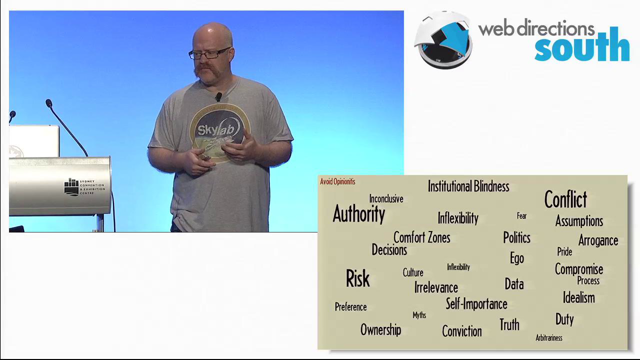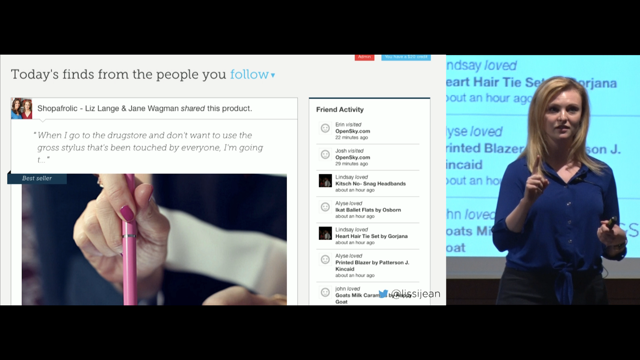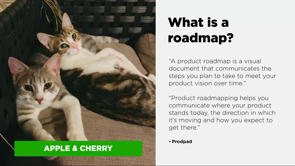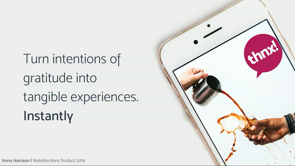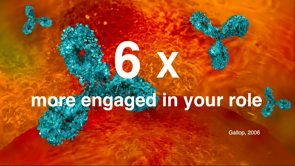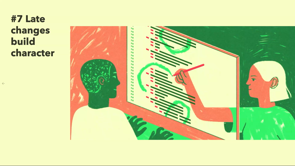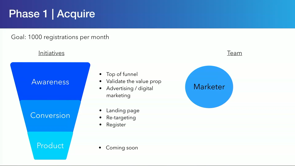Support-Driven Growth: Build your business on customer service

(bright upbeat music) - So I was at home one evening, I was on my laptop, I was having a little Skype conversation with one of my European colleagues.
And I just, out of the corner of my eye, just saw this little like (rolls tongue), on the floor, and then I felt something on my foot. And I was like UGH! Just let me be clear in a super masculine way. (audience laughs) But it was a mouse.
And the mouse just like flew across the room and kinda hit the wall and went down and I just heard the little feet and it disappeared and I could not find it and I knew somewhere in my house, is this mouse so the next day I went and got one of these gentle traps.
And I popped it in there and I caught that mouse in what turns out to be suspiciously quick time.
And so I carefully took it and I went down the road and I went to this little bush land and I let that mouse out like, yeah I did it.
And of course I had not done it.
There were more mice and then there were more traps and then there were more mice and then there were some more brutal traps.
But it became clear that this was not a problem that was gonna be solved with a better mouse trap, right? It was not a problem of a mouse trap, it was actually the chicken's fault.
The chickens in the backyard, very messy eaters. Lotta grain going everywhere.
And they uh- the mice were coming and eating the grain and then they were just kicking back in my house watching Netflix, I guess, in the evening which explains some of the weird recommendations I was getting on my Netflix account.
(audience laughs) But so the problem here was not that the mouse trap wasn't good enough.
It was just that my particular problem set was never gonna be solved with a mouse trap.
It was solved with a better chicken feeder, as it turns out. So I did that.
And that worked.
But it just makes me think about you know, this product, the best product, the "best product," it doesn't always win.
Like having the best product's not necessarily enough. Who remembers Sony Betamax? You have to be of a certain age, all right. These are my people here.
I remember when they were, half the video store was like Betamax for little while. And then a quarter of the video store, and then like a little sad isle at the end for those real hangers-on.
And then I looked it up; the very last major movie that was released on Betamax? Mission Impossible.
(audience laughs) 1996 they were still making 'em.
They're still making Mission Impossible movies, they are not making Betamax anymore.
And so what I wanted to talk about today is this idea that the product by itself can be awesome but it's not necessarily enough to concentrate on how awesome the product is. So I want to talk about service driven growth, as we do it at Help Scout.
I think there's some things in there that maybe you can extract and take for yourself. Help Scout, it's a customer messaging platform, right? So we have live chat and email support and knowledge base and the little messaging popup, that kind of thing.
And it's a pretty standard kind of SAS application. There's free trials that you can have your different paid tiers and your monthly subscriptions and annual subscriptions all pretty normal.
But I wanted to show a couple of charts.
So these are real charts.
Again I've taken the numbers off, can't share that but what I can say where you see spikes here, this is a significant improvement.
So we're looking at conversation rates of people on trial going through to becoming paying customers.
And right about here, this is where we really started to implement some of these service driven growth ideas, which I will talk about what they actually were. So that's pretty good, that was a pretty good improvement.
And here we're looking at the difference between, in the white bars, people who kind of self-served their way.
So they found Help Scout, they created their account, they went all the way through the trial to become paying customers, which is awesome.
But the difference in the blue chart, in the blue lines here are these are people who did all that, went through the trial but during that trial process, engaged with our support team in some way.
And when they became customers, on average significantly higher first billing which means they either chose a more expensive plan or they brought more users on or both.
So I want to talk about like, what do we actually do that's generating that increased conversion, that increased revenue? What is service driven growth? When you think about when I say customer service, I don't know what you have popping up in your mind, it might be something like this.
Suspiciously good looking people who are way overdressed for what looks like a pretty cramped kind of customer service cold centre type situation.
Look at this.
That's a mouse between the keyboards.
There's like this much space.
(audience laughs) Ridiculous.
I'm not... (laughs) You can only go forwards and backwards.
I'm not talking about this sort of customer service. - [Mat] And I'm not talking about this.
Sometimes people talk about this like "great customer service, Zappos." This is not good customer service.
This is good PR for Zappos sure.
- But I think even the best kind of SAS companies who do really great support still often have this sort of model, a Wac-A-Mole model where like, their customer pops up and they ask you a question and your job is just to smack them right in the face with a helpful friendly answer. And success in that sort of model is how fast can we bash them in their head with our helpfulness? And how few people can we use to do that, right? That's efficient and fast support.
So service driven growth is changing that mindset a little bit and saying, well what if it didn't have to be a cost centre that we're trying to crush down into the minimum possible amount of conversation? It doesn't have to be a cost centre, right? It could be that every conversation you have is valuable in some way.
You can make that conversation more valuable to the customer but also more valuable to you as the, as the company.
That's the idea of service driven growth.
And then there are some practical actions you can take there.
So from our customer service team, to Help Scout these are the two big things they do.
Yes, and...proactive service.
So yes, and.
We get a lot of questions like this: do you integrate with that well known web app Lettergorilla? And we say, yeah I used to work a campaign, all right, I can't say that, mate.
We say yes, okay? The answer is yes.
Here's all the details on that integration. Here's how it works.
But you don't stop there.
In a classic model you would say, we say that yes and we have a prepared answer because we get this question a lot.
We can just slam that out or we can have a bot say it for us.
But the yes and model is to say, yes and while you're here, that support person has another job.
And that job is to look at this account and figure out who are these people and what are they trying to get done? And to be able to say something like, yeah and also I see you're on trial.
Did you know we have demos or we have these classes you can attend that might help you figure out really quickly, is this gonna be a good fit for you? Or yes and I notice that you're, you're this type of customer.
We have other customers like you, and what they find really helpful in Help Scout is this particular feature, this work flow feature and this is how they use it, right? So you're just giving that support person a little bit of space and time to have a more valuable conversation. More useful for that customer who didn't need to ask the question and better for business too. Here's a proactive bit of service.
So you don't have to wait for the customer to reach out to you necessarily.
Especially if you can predict the problem that they're gonna face, right? So for Help Scout we know that when you're in the trial process one of the key points where people sometimes fall out of that trial and fail to convert is what we call the mail forward, all right? If you wanna answer your emails from inside Help Scout you need to get those emails in there in the first place.
And that means you gotta deal with whatever mail system that you're using to forward it in. And so it's a little point of friction, because there's some technical things you might need to do. And so what we do is we generate an email, we actually generate work for our support team by creating an email into our own support queue that says here's this customer that looks like we've identified them as potentially being stuck at this point.
But again we're asking the support person to do a bit of work here and say, who is this customer? Are they talking to support already about something else? Are they in a sales process that we don't want to get involved in right now? Have they got the account manager? What are they trying to get done? So we have a look at that and then we figure out, can we reach out to them and give them that little bit of handholding to get through this particular point that we know is a sticking point for people.
So when I showed that chart before of the improving conversion rate, this is essentially the key thing that we did that really helped get people past that point of friction.
But service driven growth, it's not just about how does the support team talk to the customers? It's also how does that customer-facing team integrate and help the rest of the company? So you get questions from your, or feature requests from your support team, right? That looks something like this.
You probably do, and this is good.
This is a real feature request that we get at Help Scout.
They wanna password protect their docs, okay. But as a product team for our engineering team, what do they do with that? Like that's pretty vague.
It's a clear request for a feature, but as to why, why this feature? What does it mean? What are they trying to do with it? Not super clear, so what we wanted to do is say, wouldn't it be much more helpful if it came through like this and said, the people who are asking for this feature, they're mostly 15 plus user accounts.
That might help you actually prioritise whether it's worth doing, right? Or actually even though it's all lumped together and all these people are asking for the same thing but there's actually two completely different needs there: one of them is for I've got two sets of customers that I wanna show two sets of docs to.
And one of them is for I've got staff and I've got customers and I want them to have different knowledge bases.
And so knowing that, well now maybe we don't build that feature at all because there's 20 other ways we could solve that same problem. It's just the customer has kind of preemptively jumped to the answer as they tend to do.
And they ask for that and you could deliver that to them or you could deliver it to them in a different way so...
This information's much more useful.
So how we get to this stage is we have our support people and some of them are product specialists which means they have 20, 30, 40% of their time out of the direct customer service queue.
And they kind of sit in the product side, a little bit in that spare time.
So they get to attend some product meetings, they get to have some input into the road map, they get to help with product specifications, and with future feature specs.
And they get to spend time going through the requests and figuring out this sort of stuff and packaging it up in a useful way to hand it back into the product team. So that's basically you know, some of the key things that our team do, this service driven growth approach.
So I just wanted to figure out of all that stuff what is actually useful in there and what is maybe repeatable by other people? So I've talked through what I think you need to have before you could really do this, a few of the activities you might consider doing, and then some keys to success.
For me this is the key.
I think in a lot of companies customer service is very often treated like the Knight's Watch on The Wall where you stick these people right on the edge of your territory and they're facing outwards and their job is just to prevent those customers from overwhelming us with all their feature requests and their complaints and whatever.
And you do need to do some of that obviously. But if you treat support like that, and they're sort of isolated out there on their own, even if they're really, really good at their jobs, and especially if they're really good at their jobs, what they're doing is deflecting a whole bunch of information back out of the company because they're preemptively answering it.
They're saying oh we know this, here's the answer to it, bang, bang, bang.
So what you miss out on is all the information that would be in those customer's heads.
Like how do they think about the problem that they're trying to solve? And what language are they using to describe your product and how do they think about the mental model of your product and how does that match what they think about your competitors? All of that stuff is out there and would be super helpful to you if you could get it in but if your model of support basically doesn't give people a way to put that information inside, you lose it. You need to wait for that information to flow through and that might be, you get everybody like Dom was saying, get everybody doing some support.
Everyone's talking to customers.
That's one way to do it.
You might have that product specialist.
Mailchimp have this support product analyst team that kind of sits in between support and product to do this kind of thing.
You need some way to do it.
And then you need the people on the inside to actually listen.
There's nothing more frustrating.
As a support person myself of going through all that work and passing information on and then it just sits there and nobody actually reads it? Its very frustrating.
And then the last prerequisite is this.
Identifying those key moments.
So for Help Scout one of them is that mail forwarder. We know that if we interject a little bit of human interaction right there, that it can make a difference.
There are a few of these other points.
You probably right now are thinking, what are, you know, you've probably got key points in your own journeys that you can figure out.
So...
Key activity, the big one really is this one: whereas customer service is often treated as let's reduce the number of interactions that we have and let's automate them away and let's get rid of them.
Which is useful work sometimes.
You want to create more valuable conversation. It might be that kind of handholding at a key point. It might be that, for example, if you've got a customer who upgrades their account, goes to a higher tier, has access now to new features, they're spending more money and if they're not getting more value for that money, that's a time you lose people.
That's a great time to create a conversation. You might do that on email, you might do this kind of one-on-one coaching call idea. This is if you have customer success people they probably are already doing this.
It's a really, really effective way to basically get a real customer interview with somebody who's actually trying to get something done and help them do it and you learn from them a tonne as you do it.
Not always super practical, can be a little expensive, right? So if you want to do something more scalable then you look at your live chats, your messaging, the self-service, this kind of beacon here. The nice thing about this sort of tool, and there's lots of tools that do it, is that you can identify people or certain people or people who are at a certain point in their transaction, you know? People who are on the payment screen, people who are in the trial process, and just show a chat to them.
So it's a scalable way to do it, have that conversation at that time when it's most useful.
Education, if you want to go all the way into scalability education is scaled so...
What we do at Help Scout is a lot of webinars and classes and I really like actually like, you need a budget who do a great job of this too. So what they do is similar to what Dom was saying actually, presenting a philosophy of we think this is the way you should think about this particular feature.
So for us it's customer service, you need a budget, it's budgeting.
So the philosophy of their approach and their product, their messaging about the philosophy and the approach.
They teach and then they teach how the product fits into that philosophy and so you just get customers who, when they come to use the application, they have now a better understanding of why it works the way that it does and the mental model matches what they've been told. This kind of one to many thing is very scalable. And very effective for us too.
And the last activity really is this product specialist type role for us.
Capturing feedback, lots of ways to capture feedback. But essentially it is figuring out what the customers have in their heads.
They're probably telling to support.
I heard yesterday a couple of people saying, you know it's hard to get time to do customer interviews but you know who's talking to customers all day every day and who is hearing all of this information that you would love to know is customer service people.
They just need some sort of system to capture that feedback. They need to understand what it is that you're looking for and then have a way to get it to you.
Because it's not necessarily something that they're good at or have been trained on. Speaking of...
One of the challenges that we faced at Help Scout actually is implementing this service driven growth idea was support people. Especially if they've come from other companies, their idea of what they're supposed to be doing is, how quickly can I help these people and move on because it's all about speed and volume and managing the queue.
It's all about that kind of continual process. And so we found it was kind of a culture shift for them to think about it differently. We're asking them not to speed up but to slow down, and to ask another question and to dig a little bit further and not just say, oh we'll record that feature request and pass it on, but to dig into it like what are you trying to get done there and how can we help you maybe do that? So you're gonna have to do a little of this sort of training.
And then you're gonna have to create space for them to do it.
If you ask the support team or your customer-facing people, hey I would love you to slow down and do more work please for the same amount of pay...
But still get done everything that you're already getting done, it's just not gonna happen.
So you need to create the capacity and you need to do that by, you can automate, you might...
Something that you find with a lot of product teams, and I've certainly seen this, is that there is a whole bunch of questions that are really, really repetitive, but that the product teams never see because they're very easy for support to answer. And because they're easy and fast for them to answer it's not really a pain point for the support team.
So it becomes almost invisible, except to the customers who are obviously running into them all the time.
And that's the perfect kind of thing, that just work that shouldn't be done.
Let's fix the product, put in a tool that automates what support has to do manually, put in some self-service options for the customers to do things that support currently have to do for them.
Or roll out more self-service documentation and videos, all these ways to create capacity. And then amplify people.
I think this for me is the real key.
Which is service driven growth, the idea of it is that you have these people who are talking to customers and that conversation can be super, super valuable to everybody and rather than trying to find ways to replace people, and to automate away the need for people to talk, you get rid of the useless, the kind of low value discussions like, I need to reset my password and I have to email someone to have them do that.
You get rid of that kind of work.
Amplify the person and let them do some more useful conversation so when a support person talks to a person in Help Scout, they have all this context with them.
Who is this customer? What plan are they on? What features have they been using and not using? What conversations have they had with us before? All of that stuff and then when they have that conversation it's much closer to what you would get if you had an actual relationship with these people.
And it's amplification rather than replacement of people. So for me, it all comes back to that mouse trap, right? When there is mice in my house, I don't want to become a mice murdering expert. That's not my dream to be able to murder mice really well.
I just don't want to have mice in my house. And in the same way our customers at Help Scout, they don't wanna become Help Scout, awesome Help Scout users.
They don't really care about us and they shouldn't care about us because what they want is the end result.
They want to be able to deliver good support to their customers.
And it's the same for your customers too, right? And so service driven growth is really just, is it's some activities and a bit of a mindset around that idea that what you're trying to do is not make people awesome at using a product or convince them how awesome your product is but make them, help them get to where they're trying to get to. And you have to find that out, you have to find that out by actually having conversations with people.
So if you want to read more about how we do service driven growth at Help Scout, some of the challenges we ran into and some of the different ways people talk about it, go here.
There's a whole bunch of articles around this topic that are linked up from there. And if you want to talk to me about it, happy to talk about it anytime.
Thank you so much.
(bright music) (audience applauds)
